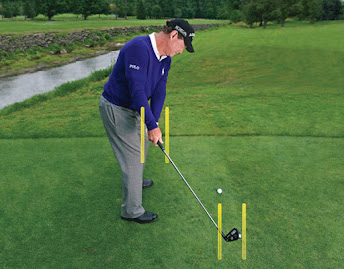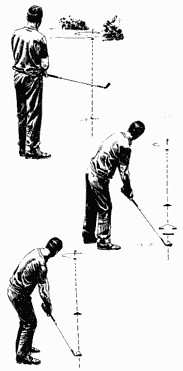Yes, we amateur golfers hear over and over again that we should swing inside-out and not over-the-top (OTT). In an unconscious effort to achieve this, we often roll the wrists and bring the hands and club inside too quickly, often well below the waist, during the takeaway. This often leads to the very thing we're trying to avoid--an OTT move that is unconsciously utilized to get the club back on line and hit the ball. The result is often pulls and pull-hooks for better players who can close the club face well; for others who can't, it produces a slice. Another symptom of this condition is a very narrow swing arc going back, with the right elbow bending too early and getting too close to the right side. The right elbow will drop into the right side coming down; it's no help to you there early.
 |
| Incorrect: club too inside |
One should always ensure that the clubhead stays outside of the hands for as long as possible, when viewing the takeaway down the line. In other words, the clubhead should only move inside somewhere in the upper trunk area--around the right shoulder. If it moves inside at waist level or even below, the club is being jerked inside by the hands and/or the right elbow is bending too early. The right elbow should ONLY FULLY bend late in the backswing. The hands stay in front of the body and only move inside due to the correct shoulder rotation. Actually, the correct shoulder turn in the takeaway and backswing SHOULD prevent you from doing this, provided you're not using the small muscles in your arms and hands to move the club.
Watch slow motion video of professional golfers (down-the-line view) and pay attention to the takeaway; specifically, look at their hands in relation to the club face, and pay attention to the bending action of their right elbow. You'll see that the right elbow bends late (and only reaches a full bend REALLY late in the backswing), and you'll notice that the clubhead stays outside of their hands (when viewed down the line) for a long time. The club head only comes inside (passes their mid-body line) somewhere around their right shoulder, not down near the waist like us inside-early schmucks. Their hands remain in front until waist high or even slightly above the waist; in other words, it's as if the hands move backwards in a straight line during the takeaway. And when the club head does finally move inside, it's due only to the motion of the shoulders turning; the arms and hands have nothing to do with it!
If you're guilty of this huge golfing transgression, you will feel like you're taking the club OUTSIDE the line when you first start doing the correct motion. But you're not going outside as long as you move everything--shoulders, arms, and hands--back together. You're on your way to achieving WIDTH in your backswing, which will help in numerous ways.
 |
| Correct: Club outside hands |
Coming down, the right elbow will drop in close to the right side around the right hip, as you fire through. In essence, the swing is going from wide to narrow to wide again in the through swing. In other words, the swing flattens some coming down, and if you traced the club head all the way through, you would see that the club head actually loops up and then under a bit, giving your swing an inside-out path naturally. The OTT swing has the opposite loop: up and over.
Another key point: When you move the arms and club back in this way with the club head staying outside your hands, you'll be prone to swaying your hips to the right, especially if that's already one of your problems. To counter this, imagine that your right hip moves straight back and towards the target in the takeaway to counter the weight of the club head staying outside the hands. In a sense, you want to think of them moving in opposite directions. Sounds silly, I know, but if you look at DTL video of pro swings, you'll notice that their right hip moves backwards slightly during the takeaway. This will get you swinging the club back on the right plane without your swing center moving off the ball.
With any "fundamental" in golf there come the gotchas. For this aspect of the takeaway, remember that the arms and hands should simply move up during the takeaway in relations to the chest, while the club head stays outside the hands! In reality, the hands also move inside (inside or back, and up simultaneously), but the inside part of the equation happens only because the shoulders are turning. The hands and arms should not roll the club open, pull the club inside, nor should they move out away from you; if your hands move out away from your body and not inside and up during the takeaway, you're setting up for an OTT swing even if the club head stays outside the hands.
This is an especially good thought for the open-clubface-at-impact slicer. Most of these slicers create their open clubface because they roll the club wide-open during the first three feet of the swing. As a result, the club usually gets way behind them at the top, and from that position, it is very difficult to square it up. There must be some wild, compensating move made coming down. If you think "hands inside, club head outside", this will keep your clubface square at waist high, and will also help put you in the proper shape at the top of your swing. It will definitely prevent that clockwise, rolling-open action of your forearms and club, which has led to many disastrous shots over the years. So remember, "your hands are in, the club head is out...as a result, you will be square throughout".
Take the club straight back low to the ground and allow the turning of your shoulder to bring the club inside on the back swing. Do not pull the club to the inside with your hands and wrists but also guard against reaching too far back. Reaching will cause you to sway off the ball. Prevent reaching by keeping your weight on the inside of your right foot.
golf long drive take away and back swing
Another great practice drill requires the use of two alignment clubs. First, place a club above the ball, parallel to the target line. Then place a second club eight to 10 inches inside this line. You’ll notice the two clubs form a path, which should be your track on which to swing the club. At first, it will probably feel like the club is moving to the outside of the target line, but after a number of repetitions, the proper swing path will begin to feel normal. Practicing this drill will help keep your shoulders, hips and feet in alignment, and promote a more on-plane backswing.
Staying On-Plane | GolfTipsMag.com
My point in that article, and in this tip, is, if you will make a conscious effort to take the club back straight for as long as possible, you'll give yourself the optimum chance for a powerful, square-faced return of the clubface to the ball.
Instruction Tip #39 - The Takeaway
The most influential component of swing arc is the position of the right arm throughout the backswing. A player with a narrow swing arc tends to fold the right arm too early or keep it unnaturally pinned to the right side all the way to the top. Both flaws pull the club in too close to the body. The player with this flaw will feel the need to free the club by throwing it way over the top and away from the body.
Stop Coming Over The Top | GolfTipsMag.com
The best way to fix an inside golf swing takeaway is to work on your wrists and the role they play. The first initial movement should be the hinging of the wrists vertically instead of horizontally. You need to ensure your left wrist does not flatten out too early which pulls the golf club on the inside. Next you need to move the golf club across your chest as you hinge your golf club vertically.
How Your Golf Swing Takeaway Is Destroying Your Golf & How To Fix It In Just 5 Minutes
What is the one flaw in the golf swing that leads to inconsistent golf shots time and time again? If you hook, slice, hit fat or thin shots and can’t figure out the cause, you may be bringing the golf club back too far to the inside. If you want to master the takeaway, then you must keep the golf club outside of your hands in the backswing. In this article, we are you to cover a few simple golf tips that you can use to stop taking the club back too far to the inside.
Stop Taking the Club Back to the Inside: Fix Your Takeaway Today!
To determine if your hands and clubhead are properly positioned, assume your normal golf stance with a full-length mirror to your right (left, if you’re left-handed). Watch your takeaway and note where the shaft points when your hands have reached the right pocket. If it points in front of you, good – the clubhead is outside your hands. If it’s already parallel to the target line or pointing behind you, your takeaway is too far inside.
A simple way to instill a “clubhead outside the hands” takeaway is to keep the butt of the club pointing at the right hip as it passes by. If the butt points left of this spot, you’ve got too much wrist action and/or an inside path.
Be mindful of the rotation of your forearms on the takeaway. If you pull the club straight back without the arms and hands rolling naturally, the clubface will become closed. Check the toe’s position at the parallel point as described above; if it points well in front of you, it’s closed.
Think “Clubhead Outside the Hands” for Solid Takeaway
A good takeaway sets the pace for a good swing. Unfortunately, many amateurs get off to a shaky start: They lift the club and roll their hands away from their body, which draws the clubhead inside and opens the face. As a result, they make erratic contact.


